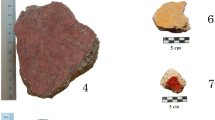Abstract
Analytical characterisation of natural earths (ochres, siennas, umbers and green earths) has been carried out using Fourier transform infrared spectroscopy (FTIR) and scanning electron microscopy (SEM) coupled to an energy dispersive X-Ray spectrometer (EDS). The study of these pigments, which are found in works of art, is very important since it can shed light on their source or the pictorial technique used. FTIR spectroscopy is suitable for the identification and differentiation of ochres and siennas. According to the matrix of the sample, FTIR allows the classification of ochres into ochres containing kaolinite and ochres containing sulphate. One of the goals of this research has been to establish a relationship between the matrix and the source of the samples tested. SEM-EDS is probably a better technique than FTIR for characterising umbers and green earths since they do not exhibit significant differences when FTIR studies are performed.





Similar content being viewed by others

References
Feller RL (ed) (1986) Artists’ pigments, vol 1. Cambridge University Press, London
Roy A (ed) (1993) Artists’ pigments, vol 2. Oxford University Press, New York
Fitzhugh EW (ed) (1997) Artists’ pigments, vol 3. Oxford University Press, New York
Hradil D, Grygar T, Hradilová J, Bezdička P (2003) Appl Clay Sci 22:223
Clark RJH (2002) CR Acad Sci II C 5:7
Bikiaris D, Daniilia S, Sotiropoulou S, Katsimbiri O, Pavlidou E, Moutsatsou A, Chryssoulakis Y (1999) Spectrochim Acta Part A 56:3
Bruni S, Cariati F, Casadio F, Toniolo L (1999) Spectrochim Acta Part A 55:1371
Edreira MC, Feliu MJ, Fernández-Lorenzo C, Martín J (2003) Talanta 59:1117
Mazzocchin GA, Agnoli F, Salvadori M (2004) Talanta 64:732
Daniilia S, Sotiropoulou S, Bikiaris D, Salpistis C, Karagiannis G, Chryssoulakis Y, Price BA, Carlson JH (2000) J Cult Heritage 1:91
Colombini MP, Carmignani A, Modugno F, Frezzato F, Olchini A, Brecoulaki H, Vassilopoulou V, Karkanas P (2004) Talanta 63:839
Grigar T, Hradilová J, Hradil D, Bezdiéka P, Bakardjieva S (2003) Anal Bional Chem 375:1154
Wouters J, Maes L, Germer R (1990) Stud Conserv 35:89
Clark RJH, Curri ML (1998) J Mol Struct 440:110
Genestar C, Pons C (2004) Thermochim Acta 413:185
Cornell RM, Schwertmann U (1996) The iron oxides: structure, properties, reactions, occurrences and uses. VCH, New York
Konta J (1995) Appl Clay Sci 10:275
Cennini C (1988) El libro del arte. Akal, Madrid
Harley RD (1982) Artists’ pigments c. 1600–1835. A study in english documentary sources. Butterworths Scientific, London
Gettens RJ, Stout GL (1966) In: Painting materials, a short encyclopaedia. Dover, New York, p 134
Casellato U, Vigato PA, Russo U, Matteini M (2000) J Cult Heritage 1:217
Acknowledgements
The authors would like to thank the Serveis Científico-tècnics (SCT) de la Universitat de les Illes Balears (UIB).
Author information
Authors and Affiliations
Corresponding author
Rights and permissions
About this article
Cite this article
Genestar, C., Pons, C. Earth pigments in painting: characterisation and differentiation by means of FTIR spectroscopy and SEM-EDS microanalysis. Anal Bioanal Chem 382, 269–274 (2005). https://doi.org/10.1007/s00216-005-3085-8
Received:
Revised:
Accepted:
Published:
Issue Date:
DOI: https://doi.org/10.1007/s00216-005-3085-8



